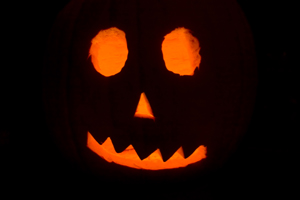The Carving Knife: Halloween's Spookiest Creature

Halloween is among the top three holidays for emergency room visits.
Pumpkin carving brings out the child in all of us. Memories of traditions like trick-or-treating, costumes and haunted houses all come to mind as the art of carving begins. But as innocent as it appears, your jack-o-lantern can land you in the emergency room.
Halloween is among the top three holidays producing the most emergency room visits with accidental lacerations and puncture wounds to the hands and fingers. John Griswold, M.D., said many of these injuries require surgery and rehabilitation.
“There is a wrong way to carve a pumpkin,” Griswold said. “Pumpkins can be slippery and tough. In a second, a knife can slip and go through the skin and out the other side. People need to be aware of the damage that can be done if you do not take precautions.”
http://www.youtube.com/watch?feature=player_embedded&v=qI35OMVnWJYThe American Academy of Orthopaedic Surgeons gives these tips to keep you and your family safe:
- When carving pumpkins remember to use specifically designed carving knives, rather than kitchen knives, as they are less likely to get stuck in the thick pumpkin skin. Carve the pumpkin in small, controlled strokes, away from yourself on a strong, sturdy surface.
- Carving knives should be kept in a clean, dry, well-lit area. Any moisture on the tools, hands or table can cause the knife to slip, leading to injuries.
- Children should never carve pumpkins. Try painting pumpkins for a fun, creative option.
- Think of fire hazards when lighting jack-o-lantern candles. Use glow sticks or artificial lights instead.
Griswold said if you cut a finger or hand, make sure the hand is elevated higher than your heart and apply direct pressure with a clean cloth to the wound to stop the bleeding.
“If continuous pressure does not slow or stop the bleeding after 15 minutes, an emergency room visit may be necessary,” Griswold said. “You can make fun Halloween memories with your family, but be be smart before you pick up the carving tools.”
Related Stories
Celebrating Veterans: TTUHSC’s General Martin Clay’s Legacy of Service and Leadership
From his initial enlistment in the Army National Guard 36 years ago to his leadership in military and civilian health care management roles, Major General Martin Clay’s career has been shaped by adaptability, mission focus and service to others.
Texas Tech University Health Sciences Center School of Nursing Named Best Accelerated Bachelor of Science in Nursing Program in Texas
The TTUHSC School of Nursing Accelerated Bachelor of Science in Nursing (BSN) program has been ranked the No. 1 accelerated nursing program in Texas by RegisteredNursing.org.
TTUHSC Names New Regional Dean for the School of Nursing
Louise Rice, DNP, RN, has been named regional dean of the TTUHSC School of Nursing on the Amarillo campus.
Recent Stories
Making Mental Health a Priority in the New Year
Sarah Mallard Wakefield, M.D., a psychiatrist with Texas Tech Physicians, talks about strategies to combat widespread and growing anxiety.
TTUHSC Cancer Researcher Honored by National Academy of Inventors
C. Patrick Reynolds, M.D., Ph.D., director of the School of Medicine Pediatric Cancer Research Center at TTUHSC, has dedicated his life as a researcher to developing treatments for childhood cancers.
TTUHSC School of Nursing Celebrates 10 Years of the Veteran to BSN Program
The TTUHSC School of Nursing recognized the 10-year anniversary of the Veteran to Bachelor of Science in Nursing (VBSN) program during the fall 2025 commencement ceremonies held Dec. 13 in Lubbock, Texas.
